Global Water Desalination Market Size and Trends
The global water desalination market is estimated to be valued at USD 19.03 Bn in 2025 and is expected to reach USD 34.58 Bn by 2032, growing at a compound annual growth rate (CAGR) of 8.9% from 2025 to 2032.
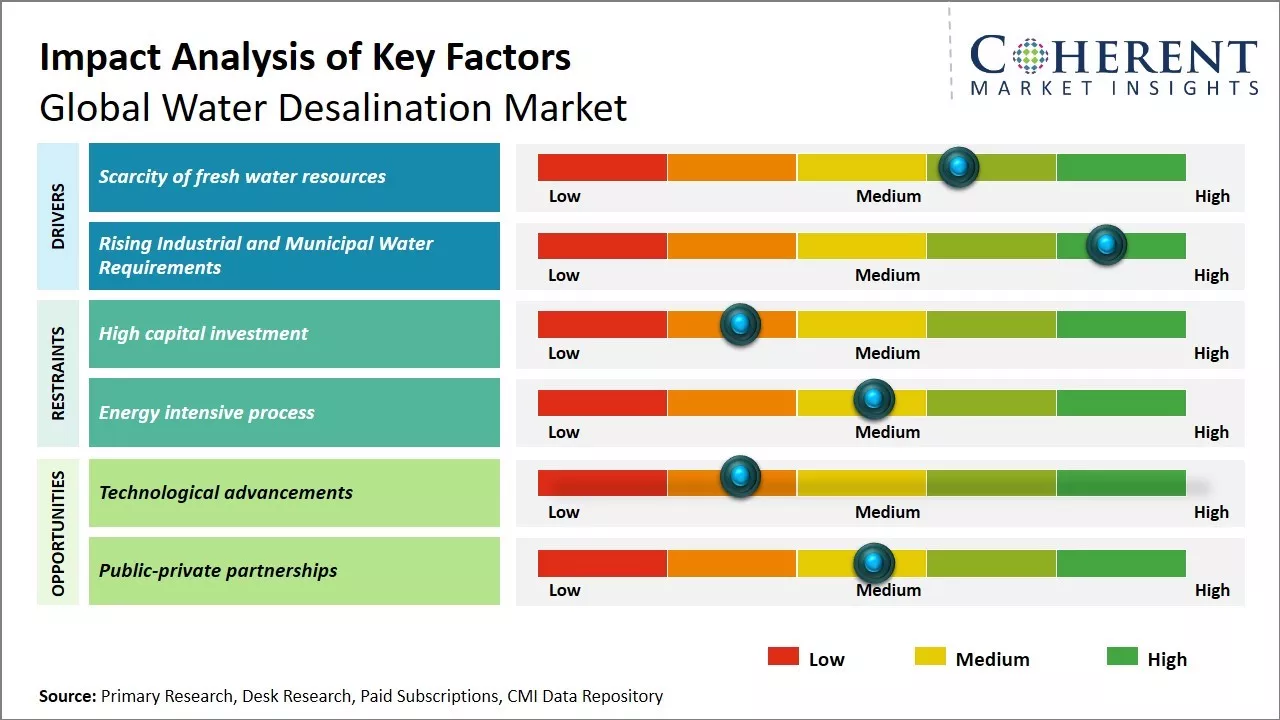
Discover market dynamics shaping the industry: Download Free Sample
Rapidly depleting freshwater resources and growing global water demand are driving considerable interest in seawater desalination. Many coastal cities and island nations rely on desalination technologies to produce potable water from seawater. The market is expected to witness significant growth over the forecast period due to growing freshwater scarcity issues worldwide exacerbated by rising population levels, economic development, and climate change. Membrane technologies such as reverse osmosis are becoming increasingly prevalent as they enable lower energy consumption compared to thermal distillation methods. Critical government initiatives and funding to develop sustainable water management solutions will further support market expansion.
Scarcity of fresh water resources
The scarcity of fresh water resources has become a major global issue that is driving the growth of the water desalination market. With the growing world population and rapidly increasing industrial activities and urbanization, the demand for water is rising sharply all over the world. However, only 3% of the water on Earth is fresh water and majority of it is locked up in ice caps and glaciers. Most of the readily available fresh water sources across many regions are already overexploited or polluted. According to experts, over 1.1 billion people globally lack access to water and a huge proportion of the world population will face water scarcity in the coming decades if sufficient augmentation of fresh water resources is not ensured. Many countries in Asia Pacific, Africa, Middle East, Australia, and Latin America are already facing severe water shortages. Rapid depletion of underground aquifers is another cause of concern. Climate change and variability in rainfall patterns, catastrophic droughts are occurring more frequently in several parts of the world, further exacerbating the water crisis. These dynamics clearly demonstrate that the limitations of natural fresh water sources are insufficient to meet the escalating demands, especially in water stressed regions. Seawater and brackish water desalination is emerging as one of the most viable solutions to overcome deficits between water demand and supply. Countries and cities are increasingly turning to desalination plants to secure alternative fresh water provision and achieve long term sustainable water management. This growing dependency on desalination for addressing fresh water needs is a major driver propelling the global market.
Market Concentration and Competitive Landscape
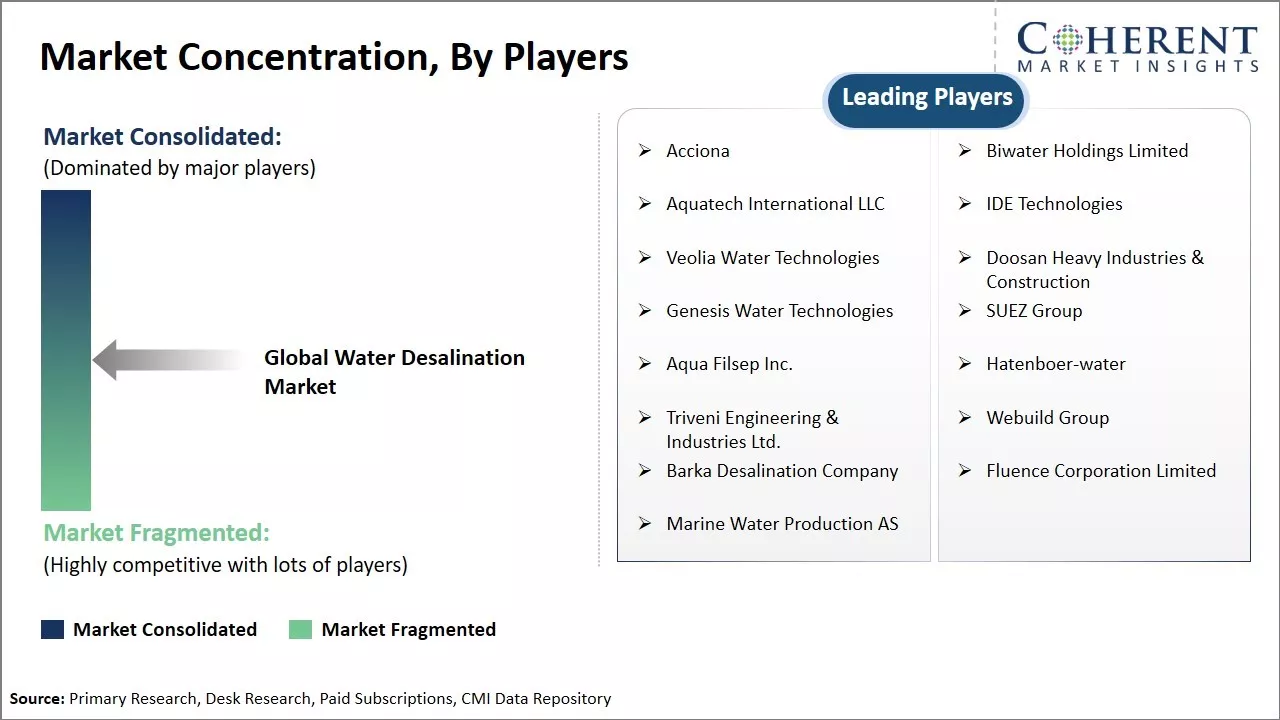
Get actionable strategies to beat competition: Download Free Sample
Rising Industrial and Municipal Water RequirementsThe massive and sustained increase in industrial production and urban population concentration worldwide have significantly raised both industrial and municipal water needs across many nations. Industries such as oil and gas, mining, energy, food and beverages, pharmaceuticals are highly water intensive. With developing economies undergoing rapid industrialization at an unprecedented scale, their manufacturing water requirements are rising exponentially and fresh water availability is failing to keep pace in several locations. At the same time, developing world urban centers are swelling with each passing year as large segments of population migrate to cities for employment and livelihood. Megacities with population exceeding 10 million people are emerging as new hubs of resource demands including fresh water.
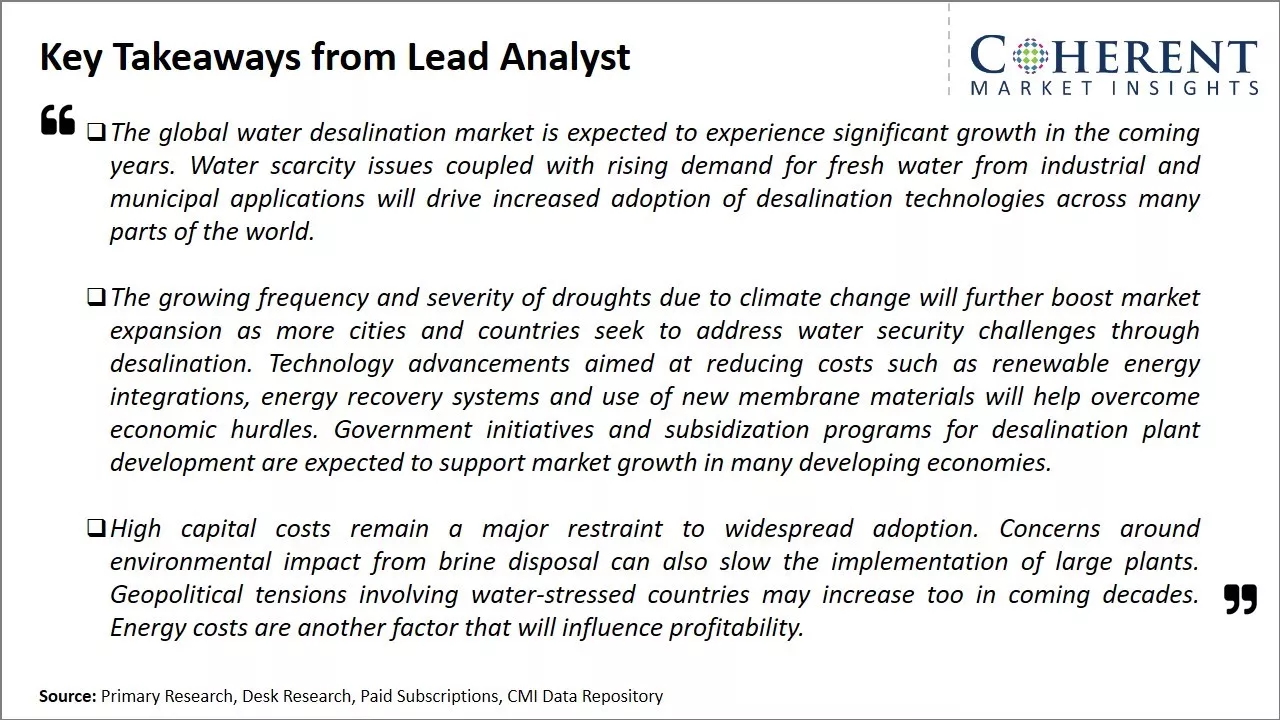
To learn more about this report, Download Free Sample
Challenges: High capital investmentThe high capital investment required for setting up desalination plants and related infrastructure is one of the major factors restraining the growth of the global water desalination market. Desalination technologies such as reverse osmosis, multi-stage flash distillation, and multi-effect distillation involve setting up large-scale seawater or brackish water treatment facilities which have huge initial setup costs. For instance, a typical seawater reverse osmosis desalination plant with a daily capacity of 100,000 cubic meters would require an initial investment of over USD 100 million. Such large capital outflows pose significant financial challenges for many municipalities and water utilities worldwide which have limited capital budgets. Additionally, desalination projects also require huge investments in pre-treatment systems, piping networks, and power plants etc. which further escalate project costs.
Opportunities: Technological advancements
Technological advancements have opened up great opportunities for growth in the global water desalination market. However, significant progress is being made in desalination technologies that can help tackle water scarcity issues in a sustainable manner. Various membrane distillation techniques are gaining ground as they allow desalination of seawater at much lower energy inputs compared to traditional thermal distillation methods. For example, solar thermal desalination plants coupled with membrane distillation are proving highly effective in arid coastal regions. Such plants have been set up in Spain, Australia and Mexico to provide potable water for local communities. The energy requirements for desalination reduce substantially, making these decentralized water production setups financially and environmentally more viable. At the same time, continued R&D is improving reverse osmosis technology which currently accounts for over half of worldwide desalination capacity. Thinner and more efficient membranes improve productivity while lowering power consumption. Pre-treatment innovations ensure membrane lifespan is extended. Integration with renewable energy can further reduce carbon footprint of desalination. For instance, the Hareswil desalination plant in Switzerland runs entirely on solar and hydropower. As per the UN World Water Development Report 2022, seawater desalination currently provides over 300 million cubic meters of potable water per day globally and is expected to grow rapidly to meet escalating demands.
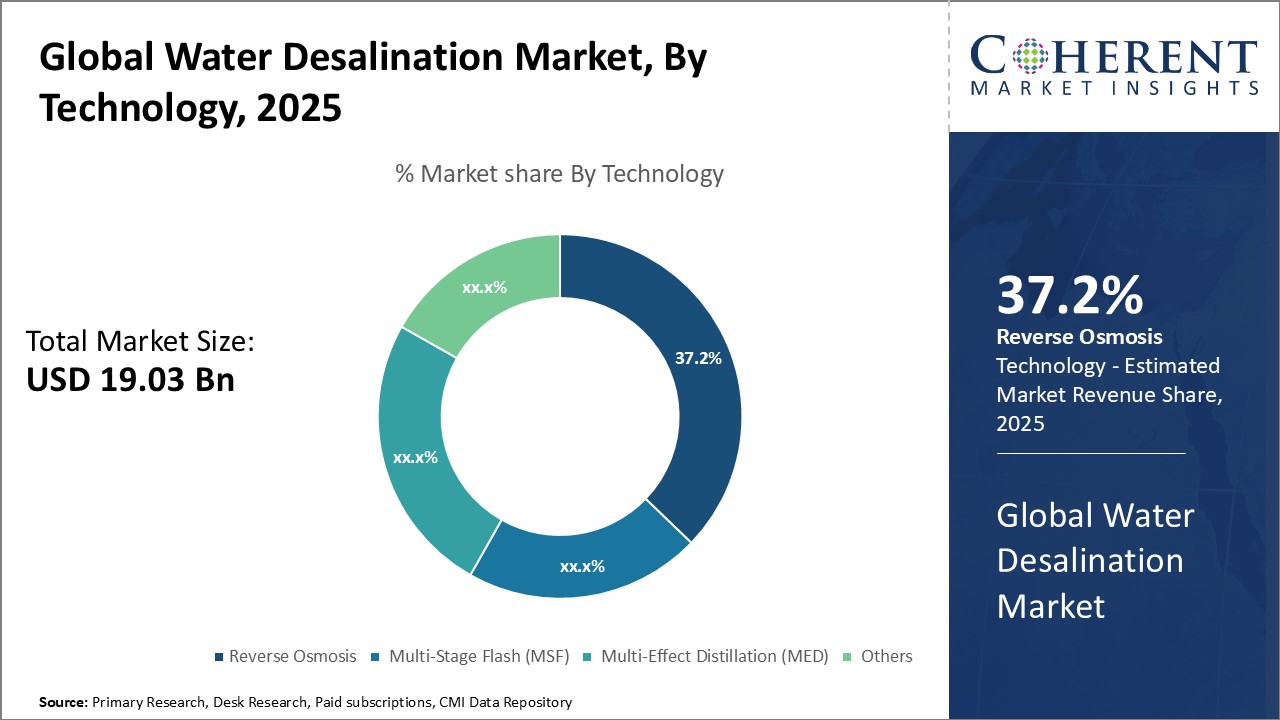
Discover high revenue pocket segments and roadmap to it: Download Free Sample
Insights by Technology: Desalination Innovation Enables Reverse Osmosis DominanceIn terms of technology, Reverse Osmosis (RO) is expected to contribute 37.2% share of the market in 2025. This is due to its outstanding efficiency and continuous technological innovation that has made RO systems increasingly cost competitive compared to other desalination technologies. RO systems use semi-permeable membranes to separate dissolved salts from water molecules. Innovation in membrane materials like thin-film composite membranes have vastly improved permeability and salt rejection rates of RO systems over time. Additionally, energy recovery devices installed with RO pumps help maximize energy efficiency. As RO technology scales to serve larger capacities, its capital costs have also declined significantly. This has enabled rapid adoption of RO even in cost-sensitive municipal applications worldwide. The consistent push for innovation in membrane and system design will allow RO to maintain its leading position in the global desalination market technology segment.
Insights by Source: Evolving Needs Drive Sea Water Dominance
In terms of source, sea water is expected to contribute 42.6% share of the market in 2025, owing to the evolving water needs of coastal cities and industries. With climate change exacerbating water scarcity globally, many coastal urban and industrial hubs have started exploring seawater desalination to diversify their water supply mix and achieve longer term sustainability. Moreover, seawater has proven highly conducive for large scale desalination due to its reliability of supply and the vast quantities available for treatment. Technological advances have also addressed prior concerns around seawater pre-treatment and membranes compatibility. The increasing dependence of coastal economies on desalinated seawater is poised to drive further growth within this segment.
Insights by Application: Municipal Needs Propel Global Demand
In terms of application, municipal is expected to contribute 43.8% share of the market in 2025, owing to escalating pressures of urbanization on limited freshwater supplies. Cities, especially in arid coastal regions, have increasingly turned to desalinated seawater to help narrow the supply-demand gap and secure water resources necessary to support growing residential and commercial water demands. While industrial applications of desalination remain an important use case, it is the untapped municipal demand in emerging nations undergoing rapid urban transitions that is expected to catapult future market prospects. With over 50% of global population residing in coastal areas, investment in municipal desalination infrastructure is anticipated to significantly increase in coming years to ensure water security of coastal megacities. This will bolster municipal application's dominant position within the overall desalination market.
Regional Insights
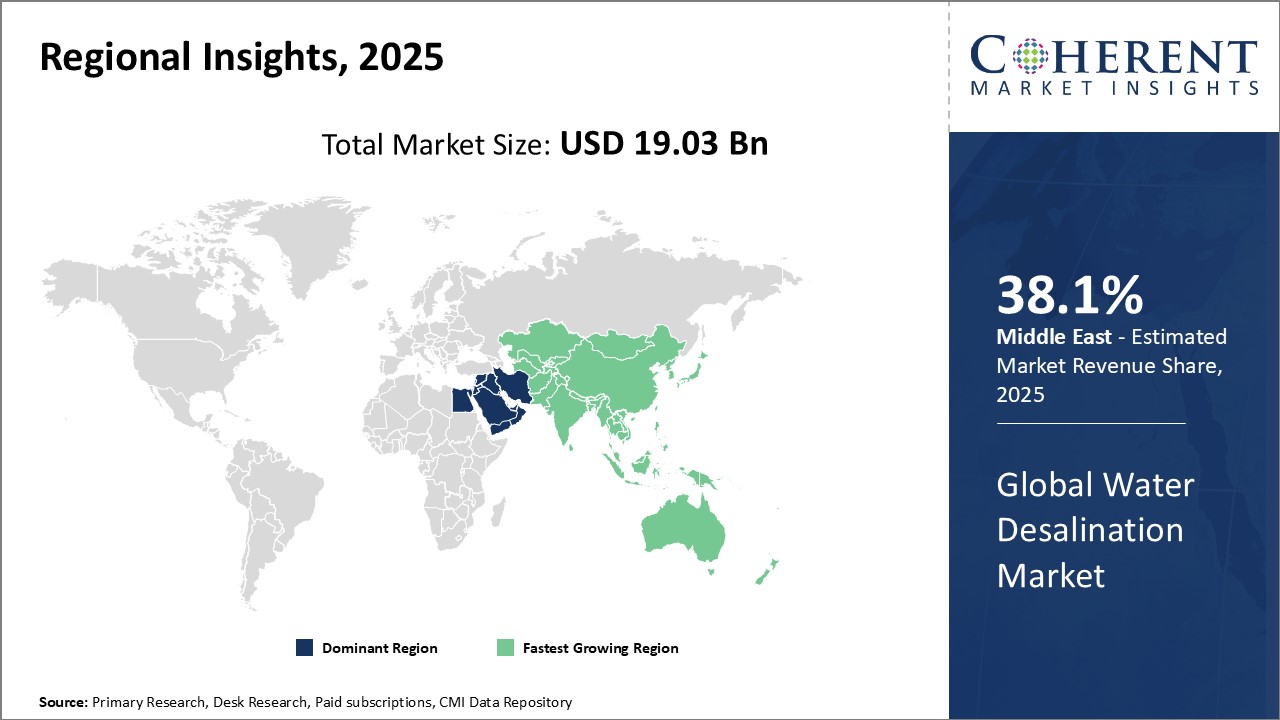
Need a Different Region or Segment? Download Free Sample
The Middle East region has dominated the global water desalination market for many years now due to acute water shortage issues across many countries in the region. The region is expected to account for 38.1% of the market share in 2025. Countries like Saudi Arabia, the U.A.E, and Qatar have arid climatic conditions which increases their dependency on desalination plants for water requirements of both municipal and industrial uses. Since fresh water sources are scarce in the region, governments have invested heavily in setting up large seawater reverse osmosis desalination plants along their coasts. This has helped them gain substantial experience and expertise in desalination technologies over the years. The region also has huge oil and gas reserves which provide it with affordable energy required to run the energy-intensive desalination process. These factors coupled with lack of alternative water sources have created a large and sustained market for desalination system suppliers and technology providers in the Middle East.
Looking at regions with high future growth potential, Asia Pacific stands out prominently. Many coastal cities and island nations in the region like China, India, Indonesia, and Australia are increasingly facing the problem of saltwater intrusion in aquifers and groundwater over-extraction. Rising populations and economic development in these areas have led to a surge in demand for fresh water. Considering the availability of coastline and seawater in plenty, these nations have started adapting seawater desalination to bridge the demand-supply gap. Countries like China and India also have a well-established industrial base which helps local desalination equipment manufacturers to grow and address the domestic requirement. Furthermore, several Pacific island countries are fully dependent on desalination for meeting their entire water needs. This makes Asia Pacific one of the fastest expanding markets for desalination systems globally over the coming years.
Market Report Scope
Global Water Desalination Market Report Coverage
| Report Coverage | Details | ||
|---|---|---|---|
| Base Year: | 2024 | Market Size in 2025: | USD 19.03 Bn |
| Historical Data for: | 2020 To 2024 | Forecast Period: | 2025 To 2032 |
| Forecast Period 2025 to 2032 CAGR: | 8.9% | 2032 Value Projection: | USD 34.58 Bn |
| Geographies covered: |
|
||
| Segments covered: |
|
||
| Companies covered: |
Acciona, Biwater Holdings Limited, Aquatech International LLC, IDE Technologies, Veolia Water Technologies, Doosan Heavy Industries & Construction, Genesis Water Technologies, SUEZ Group, Aqua Filsep Inc., Hatenboer-water, Triveni Engineering & Industries Ltd., Webuild Group, Barka Desalination Company, Fluence Corporation Limited, and Marine Water Production AS |
||
| Growth Drivers: |
|
||
| Restraints & Challenges: |
|
||
Uncover macros and micros vetted on 75+ parameters: Get instant access to report
Global Water Desalination Industry News
- In February 2024, Tamil Nadu chief minister M K Stalin inaugurated a 150 MLD desalination plant at Nemmeli in Chennai, India that will benefit nine lakh people
- In 2023, Acwa Power inaugurated Jubail 3a Iwp (Jazlah Water Desalination Company), The First Large-Scale Integrated Water Desalination - Solar Pv Project In Saudi Arabia
- In 2023, R-evolution launched the desalination initiative to accelerate global access to clean water
- In 2022, Veolia Water Technologies launched new disruptive technology for sesalination and water reuse in Asia Pacific
*Definition: The global water desalination market consists of companies that provide technologies and equipment for desalination of ocean and brackish water to make it suitable for human consumption and industrial use. Various desalination methods used are reverse osmosis, multi-stage flash distillation, multi-effect distillation and others. The desalinated water finds applications in municipal, industrial and commercial sectors worldwide to overcome water scarcity issues. Rising global water stress levels are driving the growth of this market.
Market Segmentation
- Technology Insights (Revenue, USD Bn, 2020 - 2032)
- Reverse Osmosis (RO)
- Multi-Stage Flash (MSF)
- Multi-Effect Distillation (MED)
- Others
- Source Insights (Revenue, USD Bn, 2020 - 2032)
- Sea Water
- Brackish Water
- Wastewater
- Others
- Application Insights (Revenue, USD Bn, 2020 - 2032)
- Municipal
- Industrial
- Others
- Regional Insights (Revenue, USD Bn, 2020 - 2032)
- North America
- U.S.
- Canada
- Latin America
- Brazil
- Argentina
- Mexico
- Rest of Latin America
- Europe
- Germany
- U.K.
- Spain
- France
- Italy
- Russia
- Rest of Europe
- Asia Pacific
- China
- India
- Japan
- Australia
- South Korea
- ASEAN
- Rest of Asia Pacific
- Middle East & Africa
- GCC Countries
- Israel
- Rest of Middle East & Africa
- North America
- Key Players Insights
- Acciona
- Biwater Holdings Limited
- Aquatech International LLC
- IDE Technologies
- Veolia Water Technologies
- Doosan Heavy Industries & Construction
- Genesis Water Technologies
- SUEZ Group
- Aqua Filsep Inc.
- Hatenboer-water
- Triveni Engineering & Industries Ltd.
- Webuild Group
- Barka Desalination Company
- Fluence Corporation Limited
- Marine Water Production AS
Share
Share
About Author
Yash Doshi is a Senior Management Consultant. He has 12+ years of experience in conducting research and handling consulting projects across verticals in APAC, EMEA, and the Americas.
He brings strong acumen in helping chemical companies navigate complex challenges and identify growth opportunities. He has deep expertise across the chemicals value chain, including commodity, specialty and fine chemicals, plastics and polymers, and petrochemicals. Yash is a sought-after speaker at industry conferences and contributes to various publications on topics related commodity, specialty and fine chemicals, plastics and polymers, and petrochemicals.
Missing comfort of reading report in your local language? Find your preferred language :
Transform your Strategy with Exclusive Trending Reports :
Frequently Asked Questions
EXISTING CLIENTELE
Joining thousands of companies around the world committed to making the Excellent Business Solutions.
View All Our Clients
